
Hi Gang…
Think back to 1953… a time when if you wanted your own American sports car, you had to build it. Yes…the Corvette was coming out the same year and just a few hundred would be available to the public. So if you couldn’t buy your own Corvette (John Wayne was one of the first owners of a 1953 Corvette – so it must have been hard to get one unless you had connections) – you had to build it.
Universal Studios wanted to capitalize on this new sports car excitement and in 1953, started filming “Johnny Dark” – a film about an automobile engineer, Johnny Dark, who designed a radical new car (in reality, a Woodill Wildfire, Series 2 car). When the company’s owner refuses to sponsor the car in a Canada to Mexico Sports-car race, Johnny, with the aid of the company owner’s granddaughter, steals the car and runs the race against his former friend and the race’s favored driver.
I’m pleased to share a 3 minute trailer of the 1954 Johnny Dark movie. When the trailer ends, there is a 60 second piece where Brock Yates talks about the cars used in the movie. He does a great job at reviewing the history of Woodill, but he overstates the number of kits built by about 200 copies. Then, Brock continues about the next car he calls a Glasspar, but cuts to clips of the Victress S1A with Don Taylor. This type of mistake is historically easy to make, since so little information was available about these cars even a few years ago.
I hope that has changed since Jon Greuel started our website several years ago. The final part of the 3 minute trailer shows some of the race scenes during the film. You’ll see the Grantham Stardust, Victress S1A, Glasspar G2, Irwin Lancer, Kurtis Sports Car, Tatum Special, a custom sports special, and of course the Woodill Wildfire (Idaho Special) at speed during the movie – and in color. Remember gang…this movie is now over 50 years old, and I think they did a great job back then. We can be thankful for their (Universal Studios) wonderful effort. Here’s the trailer:
I also found another short showing the Woodill Wildfire coming into Reno:
Sounds like a typical car guy movie from back then and the film has been shown on the Speed Channel in recent years many times. It starred Tony Curtis and Piper Laurie as the main characters meaning this was an “A” level film. No “B” movie here gang. In fact, when it was filmed in 1953, it was one of the first to capture race scenes from a helicopter – remember…American road racing was in it’s infancy in 1953 – this was one early racing film!
And…..better yet….it featured 5 virtually unknown fiberglass sports cars from 1953. Wow! These included:
- Glasspar G2
- Victress S1A
- Woodill Wildfire (Series 2)
- Lancer
- Grantham Stardust
Also featured were race cars or sports cars including:
- Chuck Tatum Special
- Kurtis Sports Car (KSC)
- Sports Custom Special
We think of our cars as virtually unknown today, but in 1953, these cars where in a feature film – one of the top films to be shown in 1953 – and the Corvette and Kaiser Darrin were no where to be found. Oh those were the days…. what could have been if the cars in the film continued to be produced and celebrated. We’d have Grantham Stardust, Lancer, Glasspar G2, Woodill, and Victress enthusiast groups scattered across the county. And I’d be writing about the long lost Corvette, Kaiser Darrin, and maybe Volvo P1900 sports car. What a strange world that would have been…
Ok…back to the story…
Such a film is a treasure trove for us forgotten fiberglass enthusiasts, and this is how I saw it when I started researching the film several years ago. There were many rumors about who was driving in the film, how many cars were used in each scene, who owned which cars and did the cars survive, and so on and so on and so on. Like most things in this era, I don’t like ambiguity. I rolled up my sleeves and started working.
First…. with the help of Harold Pace, I located Chuck Tatum – famous race car builder and designer from the 1950’s and someone who was one of the stunt drivers in the film. He was able to provide volumes of useful information and detail that we can both share with others and publish in our upcoming Forgotten Fiberglass book. Here’s some of what Chuck had to say:
- There are two races shown in the film. The first one is at Goletaairport in Santa Barbara California. It’s an actual race and the footage was used in the first race shown in “Johnny Dark”. I was there watching the race, and they were doing some preliminary shots and rolling film. They saw my car (the Tatum Special) and we struck a deal for both myself and the car to appear in the film.
- The second race in the film was for the movie only. It was not a real race, but it felt like it at times!
- There were no extra or duplicate fiberglass sports cars on the set, race course, backlot, or other location. In fact, as you watch the film, certain cars start to drop out of the second race toward the end. This was most likely because they broke down and could no longer be used. It was hard enough keeping some of the cars going let alone finding another example that looked just the same as the first car in the film.
- Most race scenes were shot coming down off Mount Rose near the ski area in Nevada (outside of Reno Nevada). At that altitude, the Woodill Wildfire and its F-Head engine would barely run. My business partner Andy Botto was paid $5000 at the end of the film – as a bonus for keeping the Wildfire and its engine working. That was an amazing sum of money back then. This was in addition to the salary Andy earned on the film as a co-pilot.
- We setup overnight in Reno for one of the shoots. Tony Curtis and I started the day with Cream of Wheat – he had forgotten he liked it so much!
- I roomed with Louis Tomei when we were overnight in Reno. This was at the Riverside Hotel – it’s not there anymore. When we filmed at the south shore of Tahoe, we used the hotel previously owned by Frank Sinatra. These were the opening shots that looked like we were leaving Canada and the cars start from a ramp – elevated in the air several feet. When we stayed at the South Shore, I roomed by myself.
- Andy Botto was the “co-pilot” in the Woodill Wildfire. Each car had a driver and co-pilot for all scenes in the film. I drove my Tatum Special and had a blast up and down the mountains. However… the “rider” they assigned to me for my car didn’t fare too well in terms getting sick from driving up and down the winding mountain curves and passes. In fact, the first co-pilot got scared and quit the film – they had to hire a second co-pilot on the next day to fill in from that point forward.
- In Reno during one of the shoots, most people were inside gambling. The director sent me out in the Tatum Special to race up and down the streets as loud as possible. I went out and “spun hookers” (went round and round) right in front of the famous Reno sign – “Reno the Biggest Little City in the World”. Everyone came out to see what was happening. That did the trick! People came out to see the noise and comotion I created, and we started filming the scene. It’s hard to get people away from gambling tables, you know!
- The engine noises you hear during the movie are all from my 6 cylinder GMC engine in the Tatum Special. One day they mic’d up the car and recorded sound up and down the mountain for several hours. This sound track was used in the film during the mountain race scenes. My car sure looked strange with all that equipment on it for that day.
- Several famous racing drivers were used; two had Indianapolis 500 experience, and two were sports car racing drivers. Three more were Hollywood stunt men, and the final was a sports car designer and builder. These drivers included Phil Hill (sports car racing driver), Louis Tomei (Indianapolis 500), Don Freeland (Indianapolis 500, driving the Victress S1A), Chuck Tatum (sports car racer driving the Tatum Special), H. Haile Chace – Stunt director of film, Johnny Daheim – stunt driver, Carey Loftin– stunt driver and later stunt coordinator for the movie Bullitt starting Steve McQueen. Loftin also worked on the movie “Grand Prix”, “Spinout”, “Speedway”, “Viva Las Vegas”, “On the Beach”, as well as the movie “It’s a Mad Mad World”. Erich Schultz (friend of fiberglass on our website) recently shared with me that later in life, Carey Loftin was also business partner to Max Balchowski. As reported by IMDB website, Carey Loftin was Hollywood’s greatest ever stunt driver. The last driver was Eric Irwin – driver and builder of the Irwin Lancer.
So where to next???
Universal Studios of course. On one of my trips out west, the Film Archivist for Universal agreed to meet with me and shared photos and details archived back in 1954 after the movie was over. From this research, we were able to identify all 8 cars in the movie and the names that were on the sides of their cars. These were:
- Victress S1a: Thunderbird, car #31
- Grantham Stardust: Tomahawk, car #44
- Glasspar G2: Flying Arrow, car #14
- Woodill Wildfire: Idaho Special, car #11
- Irwin Lancer: Comet, car #8
- Tatum Special: Antelope, car #7
- Kurtis Sports Car: Lightning, car #18
- Custom Sports Car: Tiger Special, car #17
Additional information was obtained about the movie, the stars, and the cars as well that I look forward to sharing in the near future.
Thanks to Frank Cornell (Woodill Wildfire Historian Emeritus), we located a set of production notes from the movie. Even Universal Studios didn’t have a copy in their archives – but they do now (thanks Frank!). The notes are 7 pages of wonderful detail explaining and promoting the film. Here’s a small excerpt:
Because most of Detroit’s contemplated domestic sports vehicles are as yet in blueprint stage, the studio made arrangements with a dozen top car designers to turn out special models for this film. These vehicles, in many respects, are years ahead of their time and are expected to be of great influence in the design of commercial cars. Designers represented in “Johnny Dark” include Howard A. Darrin who created the Kaiser-Darrin KF-161 (note: this did not make it into the film), Frank Kurtis of Kurtis-Kraft; N.J. Kraker, famous for his Grantham Stardust Special; Chuck Tatum of Stockton, California builder of the Tatum Special, and B.R. Woody Woodill – one of the nation’s foremost men in the field.
What’s neat about the rest of the production notes is that an attempt is made to explain why sports car racing is gaining popularity in America, and differences between a “Road Race” and an “Airport Race”. Both types of races are shown in this film.
Finally…what I’ll close with is the movie review of Johnny Dark, published in the New York Times on June 26th, 1954:
RIGHTLY assuming that a good many auto passengers also are driving addicts, Universal has put together a mild but rather pleasant little picture called “Johnny Dark.” Featuring Tony Curtis, Piper Laurie and Don Taylor.
Better still, the goings-on at the Fielding Motor Company, where all six work, hold some tastily authentic shots behind the automobile assembly line. The excellent Technicolor of William Alland’sproduction is even more enhancing to the climactic race, a full-throttle but standard one. Credit the photographer, nevertheless, for some extremely effective hairbreadth coverage from a helicopter, judging by the shadow.
The plot, in a nutshell, has a bright young engineer, Mr. Curtis, launching his own speed model, winning a Canada-to-Mexico race and the granddaughter of the boss. Not for a minute will anybody doubt his success on all three counts, abetted and opposed, in turn, by the smitten Miss Laurie and his pal, Mr. Taylor. What really sets and sustains the tone of the picture, however, is the familiar, seasoned amiability of Paul Kelly, Sidney Blackmer and Ilka Chase, standing by.
Pictorially, for that matter, the clean, scrubbed looks of the star trio are no less appealing throughout. Likewise their behavior. Their personal drama, as written by Franklin Coen, just isn’t particularly interesting. But under George Sherman’s casually good-natured direction, the youngsters and their elders make up some pleasant, uncomplicated people, cheerfully doing what they relish. And no harm done.
JOHNNY DARK, written by Franklin Coen, directed by George Sherman; produced by William Alland for Universal-International.
Liz Fielding . . . . . Piper Laurie
Duke Benson . . . . . Don Taylor
Scotty . . . . . Paul Kelly
Fielding . . . . . Sidney Blackmer
Abble . . . . . Ilka Chase
Miss Border-to-Border . . . . . Ruth Hampton
There’s quite a bit more to share such as interviews with Tony Curtis, letters from Don Taylor and other actors about the film, 60+ high quality still photos in high resolution used to promote the movie, promotional materials used with the film in America and abroad, and even some hometown promotions put on by small movie theaters across the country – but I hope this introductory story will suffice for now
Thanks again to Chuck Tatum, Universal Studio Archives, and Frank Cornell as well for contributing their time and efforts in documenting this film. I look forward to sharing more of this with you in the near future.
Glass on gang..
Geoff
——————————————————————–
Click on the Images Below to View Larger Pictures
——————————————————————-
- 1953: The Tatum Special with Chuck at the Wheel – At the Starting Line; South Shore of Lake Tahoe
- Cover of Multi-Page “Showman’s Manual” – Ideas Within were used to Promote “Johnny Dark”
- Suggested Theater Promotion for “Johnny Dark” Movie
- Page from Italian Theater Manual Promoting Film – Grantham Stardust Prominently Shown
- Italian Poster Promoting “Johnny Dark” in 1954 Showing Vigril Rice’s Victress S1A
- Great Black and White Ad Promoting 1954 Film
- Movie Still With Tony Curtis Designing His Car
- Woodill Wildfire at Proving Grounds – Testing Cornering at Speed
- Chuck Tatum, His Co-Driver, and Backlot Shot at Movie in 1953
- Full page ad shown in Motor Life Magazine in August 1954 – Glamour Shot of Car (and girl too) Promoting “Johnny Dark”
- Full Page Article About Tatum Special Appeared in September 1954 Issue of Motor Life
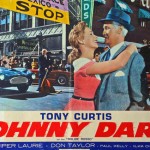
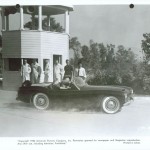
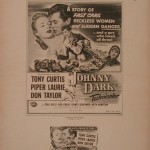
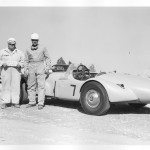
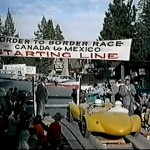
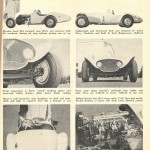
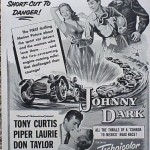

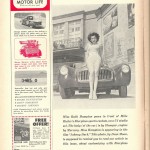
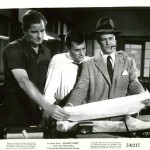
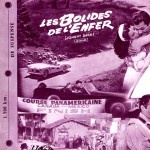

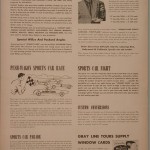
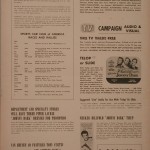




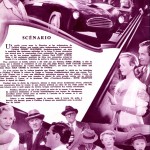
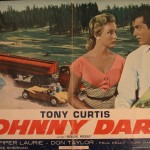

Can you find a dvd or vhs of Johhny Dark ….starring Tony Curtis?
I got a DVD of the movie on Amazon a couple of years ago, one of a kind. Soon after, I found the movie in its entirety on the web site that has all the movies on it. Just search it out.
I published a longer vignette on the film on Harlo’s The Chicane website about 2 years ago; you will find it there. The film’s Santa Barbara road race scenes include nice shots of the Cannon Special (the flattie powered cycle fendered car) and Phil Hill’s 2.9 Ferrari taken from the wooden tower at the start/finish line. On the Friday eve of the weekend (Labor Day 1953), my parents sent this eleven year old to the hotel dining room alone while they went to the King Supper Club (which had a stripper); this was the old Mar Monte near the bird refuge (still there but much changed). My waiter pointed out Curtis and Laurie seated at the next table. In the video clip Brock repeatedly mispronounces Woodill’s name as “Woodhill.” Seven years after the film was made I roomed next to Woodill’s son Mike at UCSB. He was still living in Santa Barbara a few years ago. At that first SB race the pits were on grass between the front and double back straights, not on the concrete north of the start/finish. The initial scene in the video shows the Wildfire going off road on the section leading onto the back stretch. later, we see a Jag spin in turn one, while Bill Pollack in the Mameco Spl. is just behind. My Dad finished 7th in the Fmod main in our MG N type.
Hey Geoff,
Thanks so much for helping me get a copy of Johnny Dark, what a complete surprise the movie is. It is fun, from a great story line, to the fine photography, and of course the cars are incredible. What a time capsule.
It is a real shame they do not make movies like this any more, this one is special, I know I will watch this many times. My son heard the opening music and came in and watched the film with me and totally loved it, (says a lot for the content quality of this old film). Made in the days when people did more than dare to dream. That is what is missing in our world today. Hopefully you would be able to helps some of our other readers if they get the bug. Again, can’t remember when I enjoyed an old film so much.
Hi Jim, I have been trying to get my hands on a decent copy of Johnny Dark for a long time. I have an old washed out copy now. How did you get yours? I would love to have a good copy as well. I was at the Premier of the movie in 1954 in Toledo, Ohio. It was a great movie then and is to this day. Thanks Jim, Charles